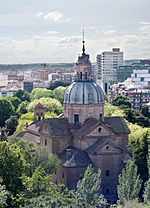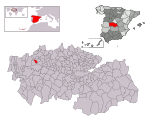Talavera de la Reina

Talavera de la Reina (Spanish pronunciation: [talaˈβeɾa ðe la ˈrejna]) is a city and municipality of Spain, part of the autonomous community of Castile–La Mancha. Its population of 83,303 makes it the second most populated municipality of the province of Toledo and the fourth largest in the region. Although the city straddles both banks of the Tagus, few kilometres downstream from the junction of the former with the Alberche, most of the urbanisation concentrates on the right (northern) bank. There are two islands in the center of the city called Isla Grande and Chamelo Island. Three bridges cross the Tagus in Talavera. The city is well known for its pottery craft. The Talavera de la Reina pottery was declared intangible cultural heritage by the UNESCO in 2019.
Excerpt from the Wikipedia article Talavera de la Reina (License: CC BY-SA 3.0, Authors, Images).Talavera de la Reina
Plaza del Pan,
Geographical coordinates (GPS) Address Phone number Website Nearby Places Show on map
Geographical coordinates (GPS)
| Latitude | Longitude |
|---|---|
| N 39.958333333333 ° | E -4.8327777777778 ° |
Address
Ayuntamiento de Talavera de la Reina
Plaza del Pan 1
45600 , San Jerónimo
Castile-La Mancha, Spain
Open on Google Maps






